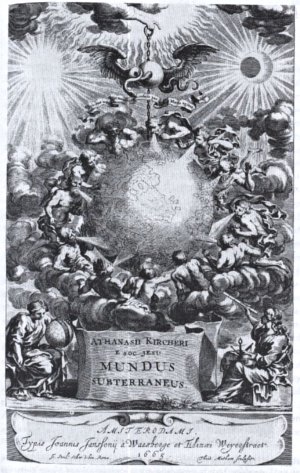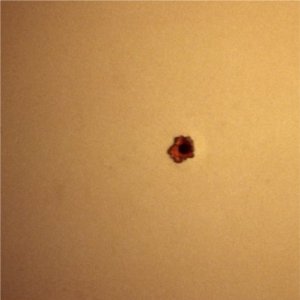
Front Page of Mundus Subterraneus by Athanasius Kircher as used in "Deep Time of the Media" by Siegfried Zielinski
For my last guest post and in response to Kelly’s question, I thought I’d address the way that I spell newMedia and my intentions behind doing so. As I mentioned in my first post; I don’t work exclusively with new technology, or even with new forms per say. However, I feel as though the content of the word addresses or is linked to concerns in newMedia art. So with this in mind, I want to take the emphasis away from the “newness” of this art form, and to readjust the focal point of this genre to be based in cultural commentary as opposed to gadgetry. Although there are some superior newMedia art pieces that implement new technologies (for instance The Dumpster by Golan Levin or Google is not the Map by Les Liens Invisibles), these project address the specific cultural implications that we are hampered with as a result of our growing integration/co-habitation with technology.
These cultural association are not something particularly new. Our relationship with technology has been a long development process, and can be traced back several hundred years. The Media Archaeology field of study has emerged in recent years in order to chart this relationship and how it has manifested itself in several time periods. Siegfried Zielinski and Erkki Huhtamo stand out as two representatives of this study and offer up alternatives to our otherwise limited notion of media art history. Jon Cates has also been tracing and tracking alternative media histories that run through Fluxus, conceptual art of the 60s, performance, and in particular, early video art based out of Chicago. In doing so, these individuals influence me (and others) to acknowledge the un-newness of newMedia culturally and historically. Oftentimes I find myself mired in gadgetry fanaticism; glorifying the new for providing solutions to problems we never really had, or giving us “new” ways to say the same old thing. This obsession—or better, preoccupation—with newness often limits the cultural productivity we could otherwise be engaging with. To recapitulate the same stale productivity in new cyberspatial ways does not justify a work. Furthermore, this speed and rate in which digitally technology is developing leaves little room for self-reflection or awareness, thus perhaps perpetuating the need for the new, and to allow our commentary on it to be so limited.

Sample photo from "Stolen Identity Project" by Andrew Schroeder
As I’ve said earlier, the ideological significance of newMedia art is vested on the metamorphosing relationship we’re experiencing with digital technology. The above image is a photography project by Andrew Schroeder that I often think of as being a good example of non-new-technology-newMedia-art. The project is a series of photographs released as a book/catalog that follow individuals that stole Schroeder’s identity in 2006. Instead of immediately reporting these individuals to the authorities he decided to tour the locations they had visited using his VISA, and take tourist-like photographs of these locations. In a strange play, he beings to tour himself, tracking himself vicariously through others passing off as him. The piece addresses the growing dissociation we’ve experienced as a result of our digital selves taking more precedence over our physical bodies. In following his captors, he isn’t concerned with who they are, or why they have done this (necessarily), but instead questions if his own identity is represented fairly by these thieves (ie, would he stay where they stayed, what would he have eaten differently in such-and-such diner, etc). The dislocation between self and identity is captured magnificently in this project, by exposing our digital privacy as containing little to no reflection on our physical identity.
Another such project that incorporates reflection on our integrated circuit as well as the media histories I have spoken about above is Sal Randolph’s Free Words project. This work incorporates using public space as a venue for distributing free literature and books. As a conceptual observation on the proliferation of mass-produced publishing, Free Words aims to undo some of the tension found in the economy of information dissemination. Using a framework that could possibly function easier on the web, Sal takes the project to the streets in order to encourage active participation with the pursuit of information/knowledge. Free Words’ “publications” are found in typical book stores across the country, and are tagged by stickers to notify interested parties. Although this project can also be viewed as an art activist piece speaking against the isolation/profiteering of the book publishing industry, I like considering this project as newMedia due to its hacking/remodeling the idea of publishing being explicitly linked to making things available to the public.
McLuhan (I know, I know) states that the translation of messages between mediums accelerates its digestions: “For the ‘message’ of any medium or technology is the change of scale or pace or pattern it introduces into human affairs.” Because the breadth and speed of our digital networked lives, we have very little time for collective conscientiousness concerning the rate at which we consume (both culture/art and otherwise). As a result, we can succumb to the shiny, glossy, and immediacy of our media culture rather than perhaps its effectiveness in communication/observation. By simply removing the proper noun quality of “New Media Art” I tend to divert the attention away from the “new” part, as well as hopefully/playfully acknowledge that the history and culture of newMedia is not necessarily exclusive to art culture. This spelling also hopes to break away from the typical implication that capitalization provides to a genre: its solidity in time and place. newMedia art history and production is intrinsically hybridized and multi-threaded. I like to think of media art history as being a rope; the more intertwined strands, the stronger it becomes.




Pingback: New guest blogger: Julia Steinmetz | Art21 Blog